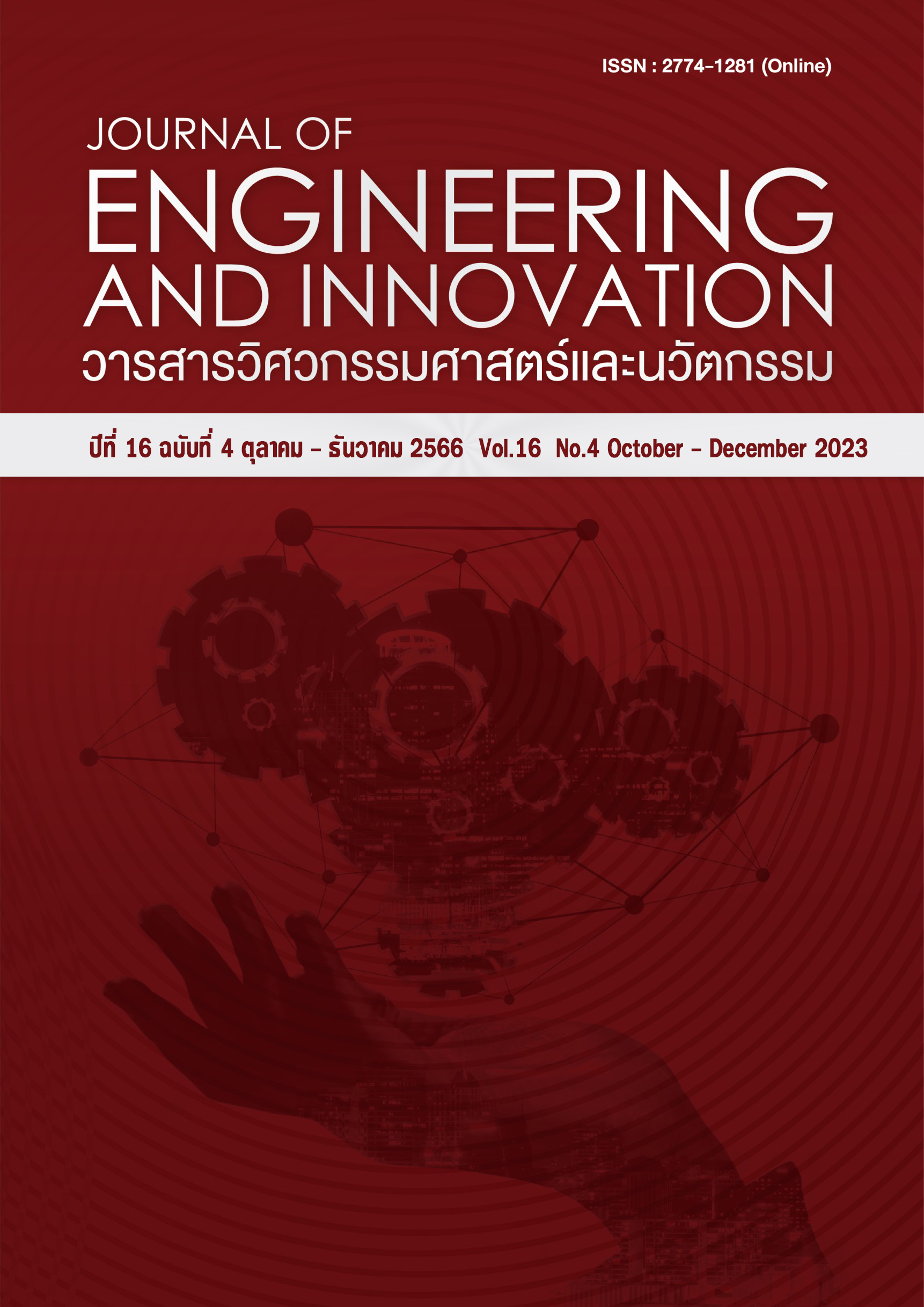การติดตามรูปแบบปรากฏการณ์เกาะความร้อนในเมืองปทุมธานี ด้วยภาพถ่ายจากดาวเทียมหลายช่วงเวลา
Main Article Content
บทคัดย่อ
งานวิจัยเรื่อง การติดตามรูปแบบปรากฏการณ์เกาะความร้อนในเมืองปทุมธานี ด้วยภาพถ่ายจากดาวเทียมหลายช่วงเวลา มีวัตถุประสงค์เพื่อ 1) ศึกษาและติดตามรูปแบบของปรากฏการณ์เกาะความร้อน 2) ศึกษาความสัมพันธ์ระหว่างปรากฏการณ์เกาะความร้อนกับสิ่งปกคลุมดิน และ 3) ศึกษาความสัมพันธ์ระหว่างปรากฏการณ์เกาะความร้อนกับจำนวนและความหนาแน่นของประชากรในจังหวัดปทุมธานีในระหว่างปี 2533 – 2563 ด้วยข้อมูลภาพถ่ายจากดาวเทียม LANDSAT-5 (TM) และ LANDSAT – 8 (OLI/TIRS) ซึ่งแบ่งออกเป็น 2 ช่วงฤดูกาล คือ ฤดูร้อน และฤดูหนาว เพื่อศึกษาค่าดัชนีผลต่างพืชพรรณ (NDVI) และดัชนีผลต่างของสิ่งปลูกสร้าง (NDBI) จากนั้นหาความสัมพันธ์ระหว่างปรากฏการณ์เกาะความร้อนกับสิ่งปกคลุมดิน จำนวนและความหนาแน่นของประชากรโดยใช้สมการถดถอยเชิงเส้นอย่างง่าย พบว่า จังหวัดปทุมธานีจะมีอุณหภูมิสูงกว่าพื้นที่ข้างเคียงที่มีความเป็นเมืองน้อยกว่าอย่างจังหวัดพระนครศรีอยุธยา และจังหวัดฉะเชิงเทรา แต่จะมีอุณหภูมิต่ำกว่าพื้นที่ที่มีความเป็นเมืองมากกว่าอย่างกรุงเทพมหานคร โดยมีอุณหภูมิอยู่ในช่วง 18 – 40 องศาเซลเซียส ซึ่งมีอุณภูมิเฉลี่ยอยู่ที่ 30.16 องศาเซลเซียส มีอุณหภูมิสูงที่สุด คือ 40 องศาเซลเซียส และมีอุณหภูมิต่ำที่สุด คือ 18 องศาเซลเซียส ผลจากการศึกษาและติดตามรูปแบบของปรากฏการณ์เกาะความร้อนมีความสอดคล้องกับข้อมูลอุณหภูมิตุ้มแห้งเฉลี่ย ความชื้นสัมพัทธ์เฉลี่ย และปริมาณฝนรวมเฉลี่ยรายเดือน ณ จุดตรวจวัด ผลจากการศึกษาความสัมพันธ์ระหว่างปรากฏการณ์เกาะความร้อนร่วมกับสิ่งปกคลุมดิน จำนวนและความหนาแน่นของประชากร พบว่า ความสัมพันธ์ระหว่างอุณหภูมิพื้นผิวกับสิ่งปกคลุมดิน ทั้งประเภทค่าดัชนีผลต่างพืชพรรณ และค่าดัชนีผลต่างสิ่งปลูกสร้างจะมีความสัมพันธ์กันในระดับที่สูงมากทั้งในฤดูร้อน และฤดูหนาว ซึ่งมีค่าสัมประสิทธิ์ (R2) เท่ากับ 0.9919 0.9884 0.9422 และ 0.9773 ตามลำดับในขณะที่ผลการศึกษาความสัมพันธ์ระหว่างปรากฏการณ์เกาะความร้อนกับจำนวนและความหนาแน่นของประชากร จะมีความสัมพันธ์กันในระดับที่ต่ำ แต่จะมีความสัมพันธ์กันในเชิงบวก ซึ่งจะพบว่า ค่าสัมประสิทธิ์ (R2) ของจำนวนประชากรและความหนาแน่นประชากร เท่ากับ 0.3080 และ 0.3918 ตามลำดับ
Article Details
References
T. Pakarnsereea, K. Chunkaob, and S. Bualertb, “Physical characteristics of Bangkok and its urban heat island phenomenon,” Building and Environment 143, pp 561–569, 2018.
D. Eckstein, V. Künzel and L. Schäfer, “Global Climate Risk Index,” Germanwatch e.V. Office Bonn, 2018.
Thai Meteorological Department, “Climate Variability and Changer,” [Online]. Available: http://www.climate.tmd.go.th/content/file/1616, 2019.
T. Tokairin, H. Mishima, and T. Kitada, “Influence of cold air from an urban green area on nocturnal temperature reduction,” [Online]. Available: http://meetingorganizer.copernicus.org/EGU2011-6414.pdf, 2011
K. Puansurin, U. Wongtragoon, B. Singchan and
S. Suwanmaneepong, “The study of participatory
monitoring of air quality and urban heat, case study Udon Thani province, Thailand,” International Journal of Agricultural Technology, 14 (7 Special Issue), pp 1693 – 1708, 2018.
P. Fu, and Q. Weng, “A time series analysis of urbanization induced land use and land cover change and its impact on land surface temperature with Landsat imagery,” RemoteSensing of Environment, Vol. 175, pp 205 – 214, 2014.
W. Wang, K. Liu,Tang, and S.Wang, “Remote sensing image-based analysis of the urban heat island effect in Shenzhen, China,” Physics and Chemistry of the Earth, Parts A/B/C, Vol. 110, pp 168 – 175, 2019.
H.Li, F. Meier, X. Lee, T. Chakraborty, J. Liu M. Schaap, and S.Sodoudi, “Interaction between urban heat island and urban pollution island during summer in Berlin,” Sci Total Environ, Vol. 636, pp 818 – 828, 2018.
W. Sanecharoen, K. Nakhapakorn, A. Mutchimwong, S. Jirakajohnkool and R.Onchang, “Assessment of Urban Heat Island Pattern in Bangkok Metropolitan Area Using Time – Series of LANDSAT Thermal Infrared Data,”Environment and Natural Resources Journal 2019 17(4), pp 87 – 102, 2019.
P. Ruthirako, “Application of Geo-information
Technology to Study Urban Heat Island
Phenomenon,” SDU Research Journal Humanities and Social Sciences, 9(3): Sep – Dec 2016,
pp 147-163, 2015. (in Thai)
N. Phengphit, S. Karnchanasutham, K. Nualchawee, P. Soytong, “The Study of Correlation Between Land Surface Temperature with Urban and Building Area, A Case Study of Amphoe Mueang Rayong, Rayong Province, Thailand,” Journal of Geoinformation Technology of Burapha University Vol. 2 No. 3 January - June 2017, pp 27- 40, 2017. (in Thai).
S. Anbazhagan and C. Paramasivam, “Statistical correlation between land surface temperature (LST)
and vegetation index (NDVI) using multi - temporal landsat TM data,” International Journal of Advanced Earth Science and Engineering, 5(1), pp 333 - 346, 2016.
U. Avdan, and G. Jovanovska, “Algorithm for
automated mapping of land surface temperature using Landsat 8 satellite data,” Journal of Sensors, 2016.
Z. Zhu, Y. Fu, C. E. Woodcock, P. Olofsson, J.E. Vogelmann, C. Holden, Y. Yu, “. Including land cover changes in analysis of greenness trends using all available Landsat 5, 7, and 8 images: A case study from Guangzhou, China (2000–2014),” Remote Sensing of Environment, 185, pp 243 – 257, 2016.
H. Wiriyasombut, and P. Traiyawong, “The Relationships between NDVI and NDWI of Land Cover Changes in Hatyai district, Songkhla province,”in proceedings of the 1st Conference of Humanity and Social Sciences, Songkhla Rajabhat University "Wisdom Power for Sustainable Development" on 20th - 21st August 2018, pp 485 – 492, 2017. (in Thai).
J. Rhee, S. Park, and Z. Lu, “Relationship between land cover patterns and surface temperature in urban areas,” GIScience & remote sensing, 51(5), pp 521 -536, 2014.
R. Amiri, Q. Weng, A. Alimohammadi and S. K.
Alavipanah, “Spatial–temporal dynamics of
land surface temperature in relation to fractional vegetation cover and land use/cover in the Tabriz urban area, Iran,” Remote Sensing of Environment, 113(12), pp 2606 – 2617, 2009.
T. Rotjanakusol, S. Sangpradid, J. Itsarawisut, and T Laosuwan, “Estimation of Land Surface
Temperature by Derivative Analysis of MOD11A2 Product Data, MODIS System,” Defense Technology Academic Journal Vol. 2 Number 6 September-December 2020, pp 76 – 85, 2020. (in Thai).
P. Chotchaiwong & S. Wijitkosum,“Relationship
between Land Surface Temperature and Land
Use in Nakhon Ratchasima City, Thailand,”
Engineering Journal, Vol.23, Issue 4, 2019.
V. Songsom, T. Suteerasak and P. Sanwang,
“The Relationship between Urban Heat Island
and Tourism at Chiangmai City,”Thailand Based
on Remote Sensing. The Journal of KMUTNB,
Vol. 30, No. 4, Oct.–Dec. 2020, pp 678 – 688.
